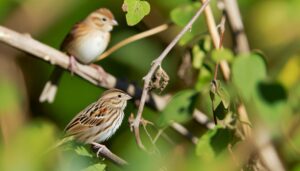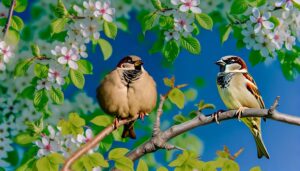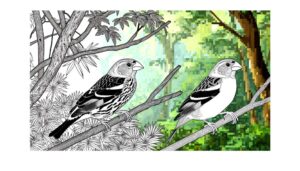Finch Vs Sparrow Vs Wren – 7 Key Differences
Finches, sparrows, and wrens exhibit distinct physical traits and behaviors. Finches showcase stout, conical beaks and vibrant colors, while sparrows have slender, pointed beaks and earthy tones.
Wrens are the smallest, with thin, curved beaks and intricate markings. Finch calls are rapid and melodic; sparrows use intricate trills, and wrens produce elaborate, high-pitched sequences.
Finches crack seeds, sparrows scavenge a variety of foods, and wrens probe for insects. Each bird's nesting materials and preferred habitats differ, reflecting their ecological niches.
Their migration patterns vary, with finches being partial migrants and wrens displaying a mixed approach. Discovering their unique adaptations reveals more about their fascinating lives.

Key Takeaways
- Finches have stout, conical beaks for cracking seeds, while sparrows have slender beaks for diverse diets and wrens have thin, curved beaks for insect foraging.
- Finches exhibit vibrant colors, sparrows have earthy tones, and wrens possess the tiniest, compact bodies with intricate markings.
- Finches sing rapid, melodic notes; sparrows use intricate trills and buzzes; wrens produce elaborate, cascading sequences.
- Finches primarily eat seeds and nuts, sparrows consume seeds, grains, and insects, and wrens focus on insects and spiders.
- Finches nest in trees, sparrows in open areas, and wrens in concealed sites with specific materials like twigs, grass, and spider silk.
Physical Characteristics
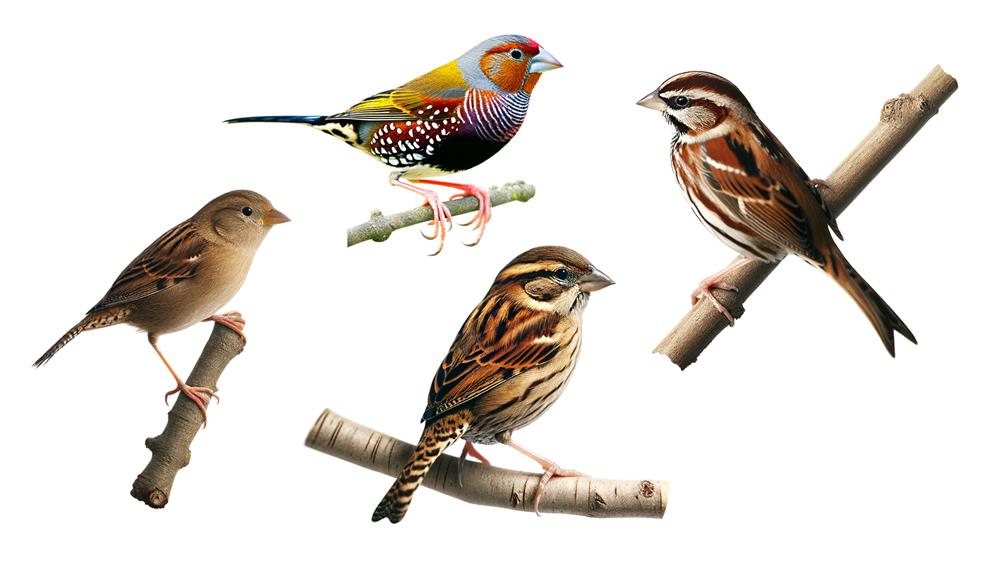
When comparing the physical characteristics of finches, sparrows, and wrens, one immediately notices significant differences in their beak shapes, plumage patterns, and body sizes.
Finches exhibit stout, conical beaks ideal for cracking seeds, while sparrows have more slender, pointed beaks suited for diverse diets. Wrens, on the other hand, feature thin, curved beaks perfect for insect foraging.
Plumage varies as well, with finches often displaying vibrant colors, sparrows showing more muted, earthy tones, and wrens characterized by intricate markings.
Body size also differentiates these birds; finches are generally medium-sized, sparrows are slightly smaller, and wrens are the tiniest, with compact, rounded bodies.
Each species' unique physical traits reflect their ecological niches and adaptive strategies.
Vocalizations
When examining the vocalizations of finches, sparrows, and wrens, it's essential to analyze their song patterns, volume, and pitch.
Each species exhibits distinct seasonal singing behaviors that reflect their breeding cycles and territorial needs.
This comparison highlights the ecological and evolutionary significance of their vocal traits.
Song Patterns Comparison
Although finches, sparrows, and wrens all produce varied and complex vocalizations, each species exhibits distinct song patterns that can be analyzed for their unique acoustic structures and behavioral functions.
Finches often utilize rapid, repetitive sequences with clear, melodic notes, which serve territorial and mate-attraction purposes.
Sparrows, on the other hand, incorporate more intricate combinations of trills and buzzes, reflecting their adaptability to diverse habitats and social structures.
Wrens produce elaborate, cascading sequences, characterized by rapid tempo changes and intricate modulations, which can deter rivals and establish territory.
Volume and Pitch
The volume and pitch of vocalizations in finches, sparrows, and wrens reveal critical adaptations to their respective environments. They showcase distinct mechanisms of sound production and auditory perception. Finches exhibit a broad range of pitches, often producing loud, clear notes that cut through dense foliage.
Sparrows, on the other hand, typically generate softer, more melodious tunes suitable for open fields and grasslands. Wrens are known for their complex, high-pitched trills, which penetrate thick underbrush.
Key differences include:
- Finches: High volume, varied pitch.
- Sparrows: Moderate volume, melodious pitch.
- Wrens: High-pitched trills, complex sequences.
- Adaptations: Environment-specific sound production.
These vocal characteristics highlight each species' unique evolutionary strategies in communication and survival.
Seasonal Singing Behavior
During the breeding season, finches, sparrows, and wrens exhibit distinct vocalization patterns, reflecting their reproductive strategies and environmental interactions.
Finches often sing complex, melodious tunes to attract females and establish territories. These intricate songs demonstrate their health and genetic fitness.
Sparrows, on the other hand, use repetitive, simpler songs to delineate their territories and ward off rivals. Their vocalizations are more persistent, emphasizing territorial defense over attraction.
Wrens produce loud, rapid trills that serve both to attract mates and to delineate territorial boundaries. Their songs are characterized by high energy and variability, often adapted to dense habitats where sound transmission is challenging.
Each species' vocal behavior underscores a unique evolutionary adaptation to its ecological niche and reproductive demands.
Feeding Habits
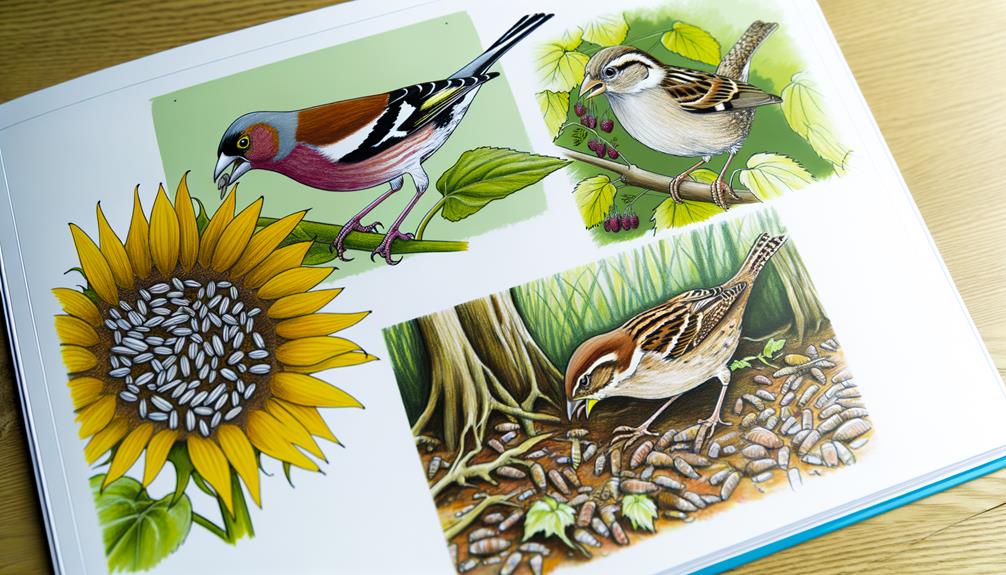
When examining the feeding habits of finches, sparrows, and wrens, their diet preferences, foraging techniques, and seasonal changes reveal distinct ecological adaptations.
Finches primarily consume seeds, employing strong beaks to crack open tough shells, while sparrows have a more varied diet that includes seeds and insects.
Wrens, on the other hand, are insectivorous by nature and exhibit highly agile foraging behaviors, which shift with seasonal availability of food sources.
Diet Preferences
Each bird species exhibits unique dietary preferences that reflect its ecological niche and foraging behavior. Finches primarily consume seeds and nuts, relying on their strong beaks to crack open hard shells.
Sparrows, being more opportunistic, have a varied diet that includes seeds, grains, and insects. Wrens, on the other hand, have a preference for insects and spiders, making them proficient insectivores.
These dietary preferences not only define their roles within ecosystems but also influence their physical adaptations and behaviors. Understanding these preferences provides insight into their survival strategies and ecological impacts.
Key Points:
- Finches: Seeds and nuts.
- Sparrows: Seeds, grains, and insects.
- Wrens: Insects and spiders.
- Dietary Adaptations: Reflect ecological niches.
Foraging Techniques
Finches exhibit a methodical foraging technique, utilizing their robust beaks to meticulously crack open seeds and nuts for consumption. Their approach allows them to access dense food sources that other birds might overlook. Sparrows, on the other hand, employ a more opportunistic strategy, often scavenging for a variety of grains, insects, and small invertebrates. Wrens showcase a distinctive probing method, using their slender beaks to extract insects and spiders from narrow crevices and foliage.
| Bird Type | Main Foraging Method | Typical Diet Components |
|---|---|---|
| Finches | Seed Cracking | Seeds, Nuts |
| Sparrows | Opportunistic Scavenging | Grains, Insects, Small Invertebrates |
| Wrens | Probing | Insects, Spiders |
Each bird's unique foraging technique reflects an adaptation to their specific dietary needs and natural habitats.
Seasonal Changes
Seasonal changes greatly influence the feeding habits of finches, sparrows, and wrens, prompting shifts in diet composition and foraging behaviors. These small birds adapt their strategies to ensure survival and peak nutrition throughout the year.
Finches: In spring and summer, they primarily consume seeds and insects, but in winter, they shift to more readily available plant material and remaining seeds.
Sparrows: They feed on insects during warmer months to meet protein needs for breeding, switching to seeds and grains in colder months.
Wrens: Wrens hunt insects and spiders year-round but increase consumption of berries and seeds in winter as insects become scarce.
Behavioral Adaptations: All three species showcase altered foraging behaviors, such as visiting feeders more frequently during winter to compensate for natural resource scarcity.
Nesting Behaviors
When examining the nesting behaviors of finches, sparrows, and wrens, one can observe distinct differences in their choice of nesting sites, materials, and construction techniques.
Finches typically build their nests in trees or shrubs using twigs, grasses, and feathers, creating a compact, cup-shaped structure.
Sparrows, on the other hand, opt for open areas like eaves or tree cavities, using coarse grass, paper, and string to form a more loosely constructed nest.
Wrens display remarkable versatility, often selecting concealed sites such as dense bushes or abandoned structures, and weaving intricate nests from fine plant fibers, moss, and spider silk.
Each species' unique nesting strategy reflects adaptations to their environment, maximizing reproductive success and ensuring the safety of their offspring.
Preferred Habitats
Each species exhibits a strong preference for specific habitats that cater to their survival needs and ecological niches. Finches thrive in diverse environments, ranging from woodlands to grasslands, and even urban areas.
Sparrows, on the other hand, prefer open fields, farmlands, and suburban gardens. Wrens favor dense vegetation and understory habitats, often found in forests and shrublands.
Finches: Adaptable to various habitats including urban areas, woodlands, and grasslands.
Sparrows: Prefer open fields, farmlands, and suburban areas, often near human habitation.
Wrens: Favor dense vegetation, forest understories, and shrublands, providing ample cover.
Habitat Specificity: Each species' choice of habitat directly impacts its foraging strategies and predator avoidance mechanisms.
This specialization underscores their ecological roles and survival strategies.
Migration Patterns
Understanding the preferred habitats of finches, sparrows, and wrens sets the stage for examining their distinct migration patterns, which are influenced by seasonal changes and the availability of resources.
Finches typically undertake partial migrations, with some populations moving southward in winter while others remain in place.
Sparrows are more varied; some species, like the American Tree Sparrow, migrate long distances, while others, such as the House Sparrow, remain mostly sedentary.
Wrens display a mixed approach—many temperate species, like the Winter Wren, migrate to warmer areas during colder months, whereas tropical wrens often stay within their established territories year-round.
These differences highlight the adaptability of each bird group to environmental pressures, ensuring their survival and reproductive success across diverse ecosystems.
Conclusion
To wrap up, the finch, sparrow, and wren each display distinct physical traits, vocalizations, feeding behaviors, nesting habits, preferred environments, and migration routes.
Notably, research indicates that finches can remember more than 50 various songs, highlighting their sophisticated vocal skills.
Recognizing these differences offers valuable perspectives on bird diversity and ecosystem dynamics. By valuing the details of these birds, we can enhance conservation initiatives and secure the existence of these captivating species for the coming generations.

